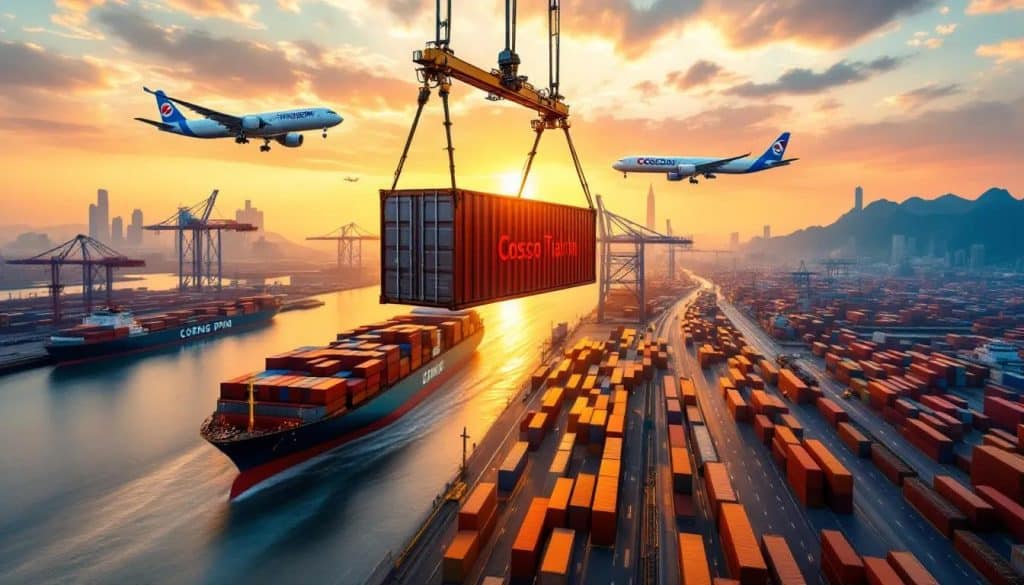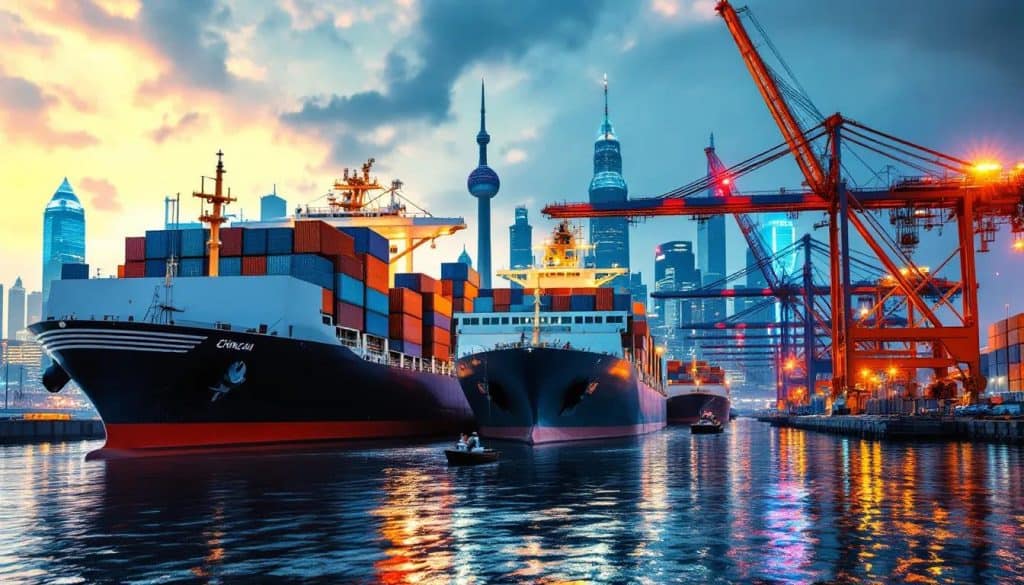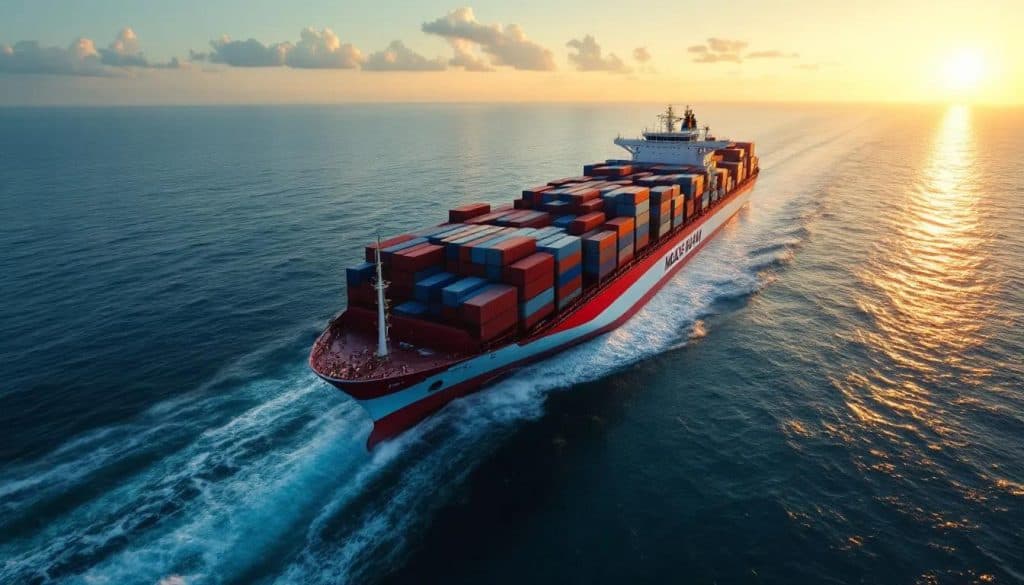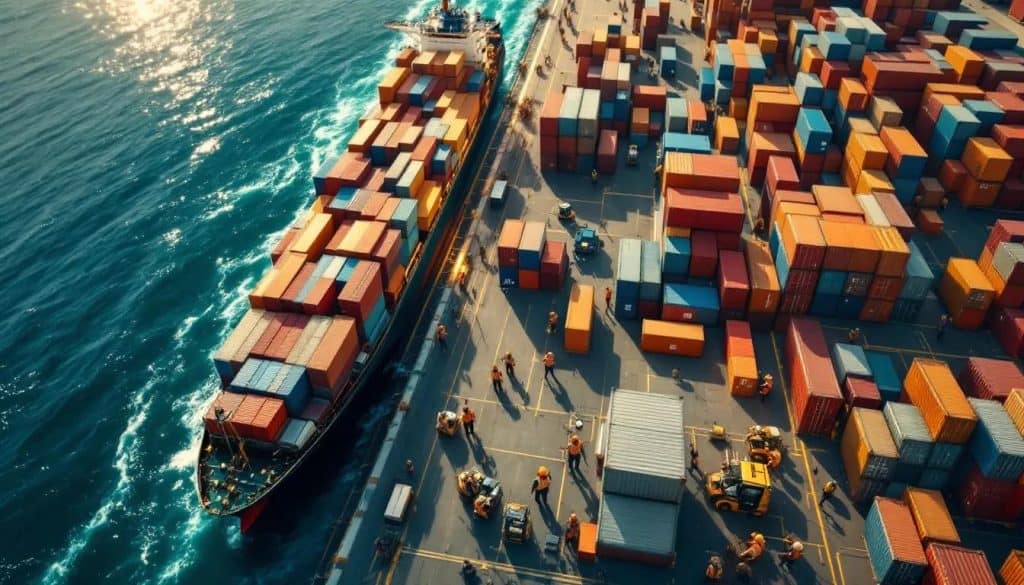Planning container shipping from China? Learn about shipping options, costs, and practical tips for efficient logistics. This guide covers everything you need for smooth, cost-effective shipping.
Key Takeaways
Container shipping from China to the USA primarily includes Full Container Load (FCL), Less than Container Load (LCL), and Express Freight options, each catering to different shipping needs and costs.
Current shipping rates for 20ft and 40ft containers are influenced by factors such as global trade conditions, with rates ranging significantly based on port of departure.
Understanding the shipping process, necessary documentation, and common challenges such as delays and damage management is essential for efficient logistics and successful delivery.
Understanding Container Shipping Options from China

Shipping from China to the USA requires knowledge of your container shipping options. The primary methods are Full Container Load (FCL), Less than Container Load (LCL), and Express Freight. Each option caters to different business needs and shipment sizes, offering various benefits and cost structures.
Full Container Load (FCL) is ideal for large shipments, utilizing an entire container for one shipper’s goods. Less than Container Load (LCL) is perfect for smaller shipments, allowing businesses to share container space. Express Freight offers rapid delivery for urgent shipments.
Here are the specifics of each option.
Full Container Load (FCL)
Utilizing a Full Container Load (FCL) entails dedicating the entire space of a container solely to the cargo of one consignor. This approach is particularly cost-effective when dealing with shipments of substantial volume, as it enables businesses to spread out the shipping expenses across a greater number of items.
By occupying an entire container, firms can economize on both time and finances, which is why FCL stands as an optimal option for many. FCL shipments generally offer faster transit times compared to LCL shipments.
Less than Container Load (LCL)
Less than Container Load (LCL) provides a versatile option for shipping smaller amounts of cargo, enabling companies to economize by sharing space in a container via an LCL shipment.
Offering weekly availability of space, LCL shipments facilitate a more streamlined shipping process by mitigating the need for transshipment and minimizing double handling.
Express Freight
Shipping using express freight services such as FedEx, UPS, DHL, and TNT for expedited delivery from China to the USA is often considered more reliable than regular mail. These carriers are capable of providing overnight shipping solutions for urgent shipments at approximately $5 per kilogram, thereby ensuring promptness and dependability in crucial delivery scenarios.
Conversely, opting for air freight when sending items from China to the USA can be a cost-effective alternative to express freight. Shipping by air is generally faster but more expensive compared to shipping by sea from China to the US. Air freight offers its own balance of benefits and compromises compared to its faster counterpart.
Current Container Shipping Rates from China to the USA

Maintaining low expenses and streamlining their supply chain is essential for businesses, which makes the current rates of container shipping from China to the USA a pivotal aspect. As it stands in March 2025, costs for transporting a 20-foot container are estimated between $1,200 and $1,850 with variations arising based on the originating port. These charges reflect broader economic circumstances encompassing international trade dynamics, periodic shifts in demand due to seasonality, along with impacts from recent geopolitical activities like imposed tariffs.
Understanding these container shipping rates helps companies discern underlying economic trends that can aid them in making strategic choices regarding their logistics plans and pricing mechanisms. Tools such as Gorto provide updates on monthly rate changes whereas Freightos facilitates access to instantaneous freight cost calculations. Freightos.com may provide real-time shipping rates for various shipping lanes from China to the USA. Both resources enable enterprises to maintain competitiveness within an ever-evolving marketplace.
Rate Comparison for Different Container Sizes
In March 2025, it is anticipated that the shipping costs for a 20-foot container will be approximately $1,400. For larger containers measuring 40 feet, the price can vary from $1,400 to $2,700. Full Container Load (FCL) shipments tend to employ flat rate pricing which makes them a more budget-friendly alternative when dealing with sizeable shipments.
On the other hand, Less than Container Load (LCL) shipments incur higher costs on a per kilogram basis. This method of shipping turns out to be more cost-effective when transporting smaller quantities of goods. The tipping point for when to choose FCL over LCL is typically around 15 cubic meters of cargo volume.
Factors Affecting Freight Rates
A variety of elements affect ocean freight rates, which are shaped by the ebb and flow of global trade, fluctuations in seasonal demand, and prevailing market conditions. The cost of shipping is also impacted by factors such as the origin and destination ports involved, the nature of goods being transported, and logistical hurdles.
Understanding these factors enables companies to predict changes in costs and devise efficient strategies for their freight management.
To find out about shipping costs from China to the rest , you can click:
20ft & 40ft Container Shipping Costs from China to Mexico
Shipping Costs for 20ft & 40ft Containers from China to Russia
Major Shipping Routes from China to the USA

Three main oceanic paths are utilized for shipping merchandise from China to the USA, traversing the Pacific, Atlantic, and Indian Oceans. These channels play a crucial role in managing the extensive trade of goods between both countries, showcasing their strong economic relationship. The efficiency of these shipping routes is considerably affected by elements like climatic changes and international commerce pacts.
For businesses involved in transportation, understanding these maritime lanes is essential for refining their distribution tactics. Being well-informed about significant departure and arrival ports enhances logistics management—crucial for prompt and cost-effective delivery of goods.
Popular Ports of Departure in China
Shanghai holds the title of China’s biggest port, playing a vital role in international shipping with substantial influence on global cargo flows. Alongside Shanghai, important centers for worldwide commerce include ports such as Shenzhen and Ningbo.
These strategic ports are instrumental in handling immense quantities of exported goods, particularly electronics, which underscores China’s status as a leading manufacturing hub on the world stage.
Key US Ports for Container Delivery
Annually, the Port of Los Angeles manages an immense volume of containers, making it the premier container port in the United States. It is accompanied by the Port of New York and New Jersey, which acts as a crucial gateway for receiving shipments from China.
The strategically positioned and well-equipped Port of Long Beach also serves as an essential node in container shipping. Its role is significant in promoting global commerce.
The Shipping Process: Step-by-Step Guide

The shipping process from China involves multiple stages, including booking, customs clearance, and final delivery. Knowing each step ensures efficient cargo movement and successful delivery. Familiarity with the process streamlines operations, reduces delays, and ensures timely delivery.
From booking your shipment to navigating customs clearance procedures and managing final delivery, each stage requires careful planning and coordination. Let’s explore these steps in detail.
Booking Your Shipment
Booking your shipment in advance minimizes delays and ensures timely delivery. Load planning software helps design optimal loading configurations, maximizing vertical space and reducing costs.
Vertical stacking and nesting of compatible goods also contribute to efficient container loading.
Customs Clearance Procedures
Shipping from China to the USA necessitates several documents for compliance with customs regulations. Proper documentation, including the Bill of Lading, Commercial Invoice, Packing List, Certificate of Origin, and Letter of Credit, is crucial for smooth customs clearance. Customs agents may pick some containers for further investigation after checking the documentation.
Freight forwarders manage documentation and ensure compliance with international shipping regulations.
Final Delivery
The concluding phase of the shipping process involves the transfer of goods from a transportation hub to their ultimate destination via door-to-door services, representing a crucial component in last-mile logistics that significantly influences delivery speed and customer satisfaction.
When opting for final delivery options, companies must assess elements like expense, rapidity, and dependability to guarantee their items reach their intended recipient promptly and intact.
Transit Times for Container Shipping from China
Shipping times for transporting containers from China can differ significantly based on the selected shipping method. Options like Full Container Load (FCL), Less than Container Load (LCL), and express delivery come with varying transit durations, which are subject to change due to elements including congestion at ports, delays in customs processing, and meteorological impacts. Understanding these shipping durations is crucial for strategizing effective logistics planning.
Assessing average transportation times allows companies to pinpoint both the quickest and most time-consuming options available for container shipment. This enables enterprises to choose a shipping solution that best suits their specific needs for timely delivery while remaining within their financial limits.
Average Transit Time Estimates
Full container load (FCL) shipments typically have a transit time of 30-40 days, while sea freight can take up to 38-45 days in optimal conditions. Air freight generally takes about 8-10 days, with express air freight delivering shipments in approximately 3-5 days. Sea freight has the longest lead time, averaging 30-40 days for a shipment from China to the US.
LCL shipments often take around 20 days, making them slower than FCL shipments, but still a viable option for smaller loads.
Fastest and Slowest Shipping Options
LCL shipments from China to the USA can reach their destination in as little as 20 days at minimum, but for container shipping, it may take considerably longer—between 38 and 45 days. Take Qingdao’s shipping route to the USA’s West Coast. Here we see an average transit time of approximately 28 days. This duration is subject to variations due to several elements including port congestion, delays in customs clearance, and inclement weather. LCL shipments take longer to process and ship than FCL due to the consolidation of multiple shipments.
It’s essential for those involved in logistics planning to understand these varying timelines so they can strategize effectively.
Choosing the Right Freight Forwarder
Choosing an appropriate freight forwarder is crucial for a smooth shipping process. Dependable freight forwarders are responsible for orchestrating logistics, handling necessary paperwork, and guaranteeing the punctual arrival of goods. Businesses seeking to engage with reputable freight forwarders may conduct online searches or solicit advice from colleagues with experience in this field. It’s advantageous to request quotes from several vendors in order to secure competitive rates and services tailored to specific requirements.
Forming enduring connections with freight forwarders can be beneficial as these relationships often result in loyalty discounts and special deals, which underscores the importance of such partnerships for recurrent shipping demands. By selecting an adept freight forwarder, companies can boost their efficiency regarding logistics and support seamless operations within international trade.
Top-Rated Freight Forwarders
Highly respected freight forwarders, such as the Mediterranean Shipping Company (MSC) and Maersk Line, provide all-encompassing solutions for shipping that encompass container shipping and safeguarding cargo with insurance. Their dependable nature and vast expertise in international trade make them notable providers.
Another commendable enterprise is Ship4wd, which extends its services to both air and ocean freight, accommodating a wide array of shipping requirements. A reputable freight forwarder is pivotal for guaranteeing effective and trustworthy service.
Evaluating Freight Forwarder Services
When assessing the services of freight forwarders, it’s crucial to take into account elements such as cost-effectiveness, the range of additional offerings, and feedback from customers. Websites such as SeaRates.com present low-cost options from a variety of freight forwarders, which can lead to considerable savings in both time and finances.
Seek out freight forwarders that offer capabilities like inventory management along with straightforward online booking processes for enhanced assistance. A meticulous examination of these aspects will aid companies in choosing a freight forwarder that is well-suited to their logistical requirements.
Cost-Saving Tips for Container Shipping
To minimize expenses, it’s vital to adopt strategies that cut down on shipping costs. Consider the following tactics:
Choosing a port in close proximity can lead to considerable reductions in transportation expenditures.
Providing regular customers with discounts and promo codes can also contribute to decreased shipping outlays.
Enhancing the utilization of container space ensures more efficient use of resources.
Engaging in negotiations for improved terms with shipping carriers may result in notable cost savings during the course of logistics operations.
We will delve into actionable advice aimed at refining container space usage and securing enhanced rates from shippers, all with an eye towards facilitating logistics that are both effective and economical.
Optimizing Container Space
Optimizing the packing of containers by reducing unused space enables the shipment of more goods without accruing extra costs. The use of standardized packaging contributes to better container utilization, thereby diminishing space that is not used effectively. Businesses can cut expenses on return journeys through collaborative logistics strategies that involve sharing container space.
The employment of backhaul optimization instruments aids in locating chances for hauling merchandise during return trips, which improves the efficiency with which container space is utilized.
Negotiating Better Rates
By obtaining quotes from various freight forwarders, one can effectively compare and negotiate to secure advantageous rates for shipping. Establishing robust connections with freight carriers may result in unique discounts and improved rates as the relationship matures.
Developing enduring partnerships contributes to a cost structure that is more beneficial for regular shipments, ultimately boosting the efficiency of logistics operations.
Cargo Insurance: Importance and Options
It’s imperative to secure your shipments with cargo insurance as it offers protection against possible losses or damages that may occur while in transit. Opting for comprehensive cargo insurance ensures full coverage, whereas the minimal protection is afforded by basic carrier coverage. To verify the extent of coverage and the value insured, obtaining an Insurance Certificate is critical. By making sure your shipment has sufficient insurance, you can shield yourself from financial setbacks triggered by unexpected incidents.
Understanding the different kinds of cargo insurance and determining which policy best fits your needs are key components of efficient risk management when shipping goods. Below are diverse options along with guidelines to help select suitable cargo insurance for your shipments.
Types of Cargo Insurance
Cargo insurance with all-risk coverage provides the highest level of protection, defending against almost any type of physical harm or loss that may occur to the cargo. This extensive insurance typically includes a wide array of potential risks, except for those which are clearly listed as exclusions.
Conversely, named perils policies deliver more limited safeguarding by covering only certain dangers such as theft and fire. When selecting an appropriate form of insurance, particular hazards pertinent to the cargo’s intended destination should be taken into account. This is particularly true for regions affected by geopolitical unrest.
How to Choose Cargo Insurance
When choosing cargo insurance, it is crucial to evaluate the shipment’s worth because shipments with higher values might necessitate a broader coverage. Goods transported by sea are protected by marine cargo insurance, whereas land cargo insurance offers protection for goods moved via road or rail.
Businesses can decide on suitable cargo insurance plans more effectively when they consider both the value of their shipments and associated risk factors.
Common Challenges and Solutions in Container Shipping
The industry of container shipping is currently grappling with several obstacles such as surging demand, bottlenecks at US ports and storage facilities, along with a contraction in air freight capacity. These difficulties have been intensified by the COVID-19 pandemic, leading to substantial upheavals within the realm of shipping. Production in China is back to normal but COVID-19 has caused challenges including high demand and delays at US ports. Companies face additional hurdles when it comes to securing space on ships and dealing with fluctuating prices, especially those transporting goods from China. It’s vital for these businesses to recognize these issues and employ strategies that will enhance their ability to conduct efficient shipping operations.
We must tackle prevalent problems including navigating through delays and addressing incidents involving merchandise damage. We aim to offer actionable guidance enabling enterprises to adeptly control these concerns ensuring an effective management of their logistical needs.
Dealing with Delays
Congestion at ports frequently results in longer waiting periods for ships, necessitating the need for efficient scheduling and plans for unforeseen events. Enterprises should contemplate utilizing different ports and adopt flexible shipping timetables to handle postponements.
Taking preventive action against potential hold-ups aids organizations in preserving the effectiveness of their supply chains and guarantees that deliveries are made promptly.
Handling Damaged Goods
Protecting shipments from diverse risks, especially when faced with damaged goods, is essential through cargo insurance. The market offers several forms of cargo insurance policies like all-risk and named perils coverage that cater to different needs.
In the event that your cargo suffers damage while in transit, it’s vital to quickly file a claim with your insurance provider and furnish them with comprehensive evidence of the damage incurred. Selecting an appropriate cargo insurance plan and being well-versed in the claims procedure aids companies in reducing monetary setbacks and secures their shipments effectively.

Documents Required for Shipping from China to the USA
Having the correct and complete paperwork is crucial for ensuring a seamless customs clearance, which can greatly expedite the shipping process. Vital documents such as the Bill of Lading, Commercial Invoice, and Insurance Certificate are key to adhering to international regulations for shipping and avoiding delays during customs inspections. Understanding what documentation is required is fundamental to achieving successful outcomes in shipping endeavors.
Let’s delve into details about these critical documents and their function within the framework of the shipping procedure.
Bill of Lading
The Bill of Lading (BoL) is a crucial legal document that outlines the specifics regarding the shipper, receiver, and terms of shipping. It functions as both a receipt for the merchandise being shipped and an agreement detailing the transaction between the party shipping goods and the carrier.
When accurately filled out, it facilitates seamless customs clearance and ensures that delivery proceeds without issue.
Commercial Invoice
A Commercial Invoice plays a vital role in the customs process by offering key information regarding a shipment’s value and transaction details. It must contain certain elements such as the invoice number, information about both buyers and sellers, detailed descriptions of products, their values, and terms of payment.
Ensuring that the Commercial Invoice is prepared accurately is paramount for adherence to regulations and to promote seamless customs clearance.
Insurance Certificate
A certificate of insurance is essential because it verifies that your cargo has protection from possible hazards and damages while in transit. There are various forms of cargo insurance, such as all-risk policies that encompass a broad spectrum of potential damages and named perils policies that protect against only those risks explicitly outlined.
To select the appropriate cargo insurance, assess the value of the shipment, related risks, and particular needs pertaining to your business to confirm sufficient coverage.
Summary
To effectively participate in international trade, especially when shipping from China to the USA, it’s crucial to have a clear understanding of container load options. Shipping methods such as Full Container Load (FCL), Less than Container Load (LCL), and Express Freight each provide distinct advantages depending on the scale of shipments and time sensitivity required. Ordering a shipping container from China is a straightforward process involving suppliers and shipping agents. Essential factors like current freight rates, prominent shipping routes, and a comprehensive grasp of the entire shipping process are imperative for businesses aiming to streamline their logistics.
Selecting an adept freight forwarder who can help with cost-effective strategies while ensuring robust cargo insurance coverage is instrumental in facilitating seamless shipment operations. Tackling typical hurdles such as delays or damage during transit helps sustain supply chain efficiency while safeguarding your cargo against unforeseen mishaps.
Looking ahead into 2025, maintaining awareness about changes within the shipping sector will position companies well for success in global markets. Leveraging these insights and recommendations within your own transport processes will enhance your venture’s capacity to prosper amidst international commerce dynamics.
Frequently Asked Questions
What are the main shipping options available from China to the USA?
The primary shipping options from China to the USA are Full Container Load (FCL), Less than Container Load (LCL), and Express Freight, each designed to accommodate varying shipment sizes and urgency.
Choosing the right option depends on your specific needs.
How much does it cost to ship a 20ft container from China to the USA in 2025?
Shipping a 20ft container from China to the USA in 2025 costs between $1,200 and $1,800, varying by the departure port.
It’s essential to check current rates for accurate pricing.
What documents are required for customs clearance when shipping from China to the USA?
To ensure smooth customs clearance when shipping from China to the USA, you need to prepare the Bill of Lading, Commercial Invoice, and Insurance Certificate. Proper documentation is crucial for compliance with international shipping regulations.
How can businesses save on container shipping costs?
To save on container shipping costs, businesses should optimize container space, negotiate better rates, utilize nearby ports, and leverage discounts for frequent shipments.
Implementing these strategies can significantly reduce overall shipping expenses.
What are the fastest and slowest shipping options from China to the USA?
Express air freight is the fastest shipping option from China to the USA, delivering in about 3-5 days, while sea freight is the slowest, taking 30-45 days.


